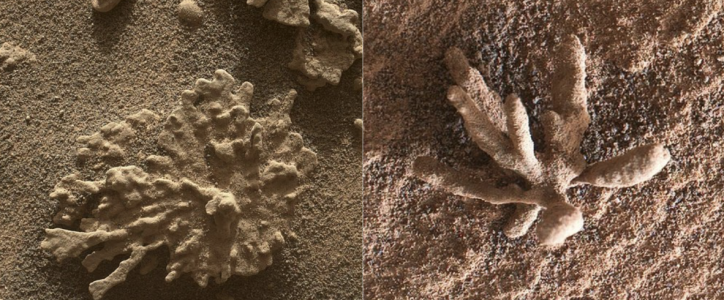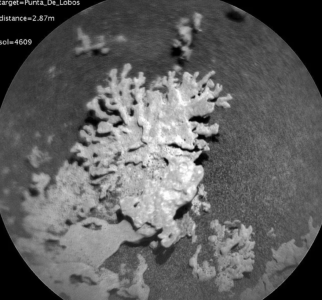NASA’s latest Mars find sparks new questions about ancient life
By
Veronica E.
- Replies 0
If you’ve ever looked up at the night sky and wondered whether we’re alone, you’re not the only one.
For decades, the Red Planet has fascinated scientists, storytellers, and everyday stargazers alike.
Now, a fresh set of images from NASA’s Mars rovers is once again stirring up conversation about the possibility of ancient life.
The latest find—a coral-shaped rock captured by the Curiosity rover—has sparked speculation from space fans and renewed scientific interest in Mars’ watery past.
While it’s not definitive proof of life, the discovery is one more clue in the long, unfolding mystery of our planetary neighbor.

A coral-like rock in the Martian desert
On July 24, 2025—Curiosity’s 4,609th day on Mars—the rover photographed a strange rock formation in Gale Crater.
Its twisting, branching shape immediately drew comparisons to coral reefs on Earth, prompting some social media users to suggest it could be a fossil.
NASA scientists, however, have a more grounded explanation: billions of years ago, mineral-rich water seeped into cracks in the bedrock, leaving behind hardened mineral veins.
Over time, Martian winds eroded the softer surrounding rock, revealing the intricate structure we see today.
These features, known as "boxwork" formations, help researchers reconstruct Mars’ ancient climate and geology.
Also read: From zero gravity to hard reality: NASA astronauts face new challenges on Earth
Not the first unusual find
Curiosity has uncovered similar formations before, including a flower-like rock in 2022 formed by the same mineral-depositing process.
Meanwhile, the Perseverance rover—exploring Jezero Crater—has made its own remarkable discoveries.
In 2024, it found a rock named Cheyava Falls, shaped like an arrowhead and marked with vein-like ridges, reddish hematite, and unusual “leopard spots.”

These spots contain iron and phosphate, elements that on Earth are sometimes linked to fossilized microbial life.
While not proof, such finds keep the possibility of Mars’ habitability on the scientific radar.
Also read: A NASA intern stole moon rocks worth $21 million—the shocking details revealed
What it means for the search for life
NASA is not claiming these formations are fossils, but each new discovery strengthens the case that Mars once had the ingredients for life.
The planet’s ancient presence of water, the right minerals, and potential energy sources mirror some of the key conditions that supported life on Earth.
Scientists are also intrigued by how these features resemble Earth’s own geologic records, hinting at shared processes across planets.
The hope is that one day, returned rock samples will offer more definitive answers.

Also read: From zero gravity to hard reality: NASA astronauts face new challenges on Earth
Looking ahead
Curiosity and Perseverance will continue their missions, gathering images, data, and samples for years to come.
Plans are also underway for future missions—including an international effort to return Martian samples to Earth.
For scientists, each discovery offers a deeper understanding of Mars’ evolution and possible habitability.
For the rest of us, it’s a reminder that space exploration still holds plenty of wonder—and that the answers to some of our biggest questions may be waiting just a few million miles away.
Read next: A Soviet spacecraft is falling to Earth — will it land closer than you think?

Do you think Mars once had life, or are these formations just the work of nature? What would it mean for us if proof was found? Share your thoughts and theories in the comments!
For decades, the Red Planet has fascinated scientists, storytellers, and everyday stargazers alike.
Now, a fresh set of images from NASA’s Mars rovers is once again stirring up conversation about the possibility of ancient life.
The latest find—a coral-shaped rock captured by the Curiosity rover—has sparked speculation from space fans and renewed scientific interest in Mars’ watery past.
While it’s not definitive proof of life, the discovery is one more clue in the long, unfolding mystery of our planetary neighbor.

A new discovery is sparking fresh curiosity about the mysteries of Mars. Image Source: YouTube / ElderFox Documentaries.
A coral-like rock in the Martian desert
On July 24, 2025—Curiosity’s 4,609th day on Mars—the rover photographed a strange rock formation in Gale Crater.
Its twisting, branching shape immediately drew comparisons to coral reefs on Earth, prompting some social media users to suggest it could be a fossil.
NASA scientists, however, have a more grounded explanation: billions of years ago, mineral-rich water seeped into cracks in the bedrock, leaving behind hardened mineral veins.
Over time, Martian winds eroded the softer surrounding rock, revealing the intricate structure we see today.
These features, known as "boxwork" formations, help researchers reconstruct Mars’ ancient climate and geology.
Also read: From zero gravity to hard reality: NASA astronauts face new challenges on Earth
Not the first unusual find
Curiosity has uncovered similar formations before, including a flower-like rock in 2022 formed by the same mineral-depositing process.
Meanwhile, the Perseverance rover—exploring Jezero Crater—has made its own remarkable discoveries.
In 2024, it found a rock named Cheyava Falls, shaped like an arrowhead and marked with vein-like ridges, reddish hematite, and unusual “leopard spots.”

In 2022, the rover came across a rock shaped like a flower, formed long ago when water deposited minerals that eventually hardened together. Image Source: The Daily Mail / © NASA/JPL-Caltech/MSSS/Kevin M. Gill.
These spots contain iron and phosphate, elements that on Earth are sometimes linked to fossilized microbial life.
While not proof, such finds keep the possibility of Mars’ habitability on the scientific radar.
Also read: A NASA intern stole moon rocks worth $21 million—the shocking details revealed
What it means for the search for life
NASA is not claiming these formations are fossils, but each new discovery strengthens the case that Mars once had the ingredients for life.
The planet’s ancient presence of water, the right minerals, and potential energy sources mirror some of the key conditions that supported life on Earth.
Scientists are also intrigued by how these features resemble Earth’s own geologic records, hinting at shared processes across planets.
The hope is that one day, returned rock samples will offer more definitive answers.

NASA’s Curiosity rover has sent back a striking photo of a rock on Mars shaped like coral. Image Source: The Daily Mail / © NASA/JPL-\Caltech/LANL/CNES/CNRS/IRAP/IAS/LPG.
Also read: From zero gravity to hard reality: NASA astronauts face new challenges on Earth
Looking ahead
Curiosity and Perseverance will continue their missions, gathering images, data, and samples for years to come.
Plans are also underway for future missions—including an international effort to return Martian samples to Earth.
For scientists, each discovery offers a deeper understanding of Mars’ evolution and possible habitability.
For the rest of us, it’s a reminder that space exploration still holds plenty of wonder—and that the answers to some of our biggest questions may be waiting just a few million miles away.
Read next: A Soviet spacecraft is falling to Earth — will it land closer than you think?
Key Takeaways
- NASA’s Curiosity rover photographed a coral-like rock formation in Gale Crater on July 24, 2025, sparking debate about possible signs of ancient life.
- Scientists believe the structure formed billions of years ago from mineral-rich water filling rock cracks, later exposed by wind erosion.
- Other Mars rover finds, including Perseverance’s Cheyava Falls rock, show chemical signatures and features sometimes linked to microbial life on Earth.
- These discoveries suggest Mars once had water and conditions that could have supported life, though no direct evidence of past organisms has been confirmed.
Do you think Mars once had life, or are these formations just the work of nature? What would it mean for us if proof was found? Share your thoughts and theories in the comments!






